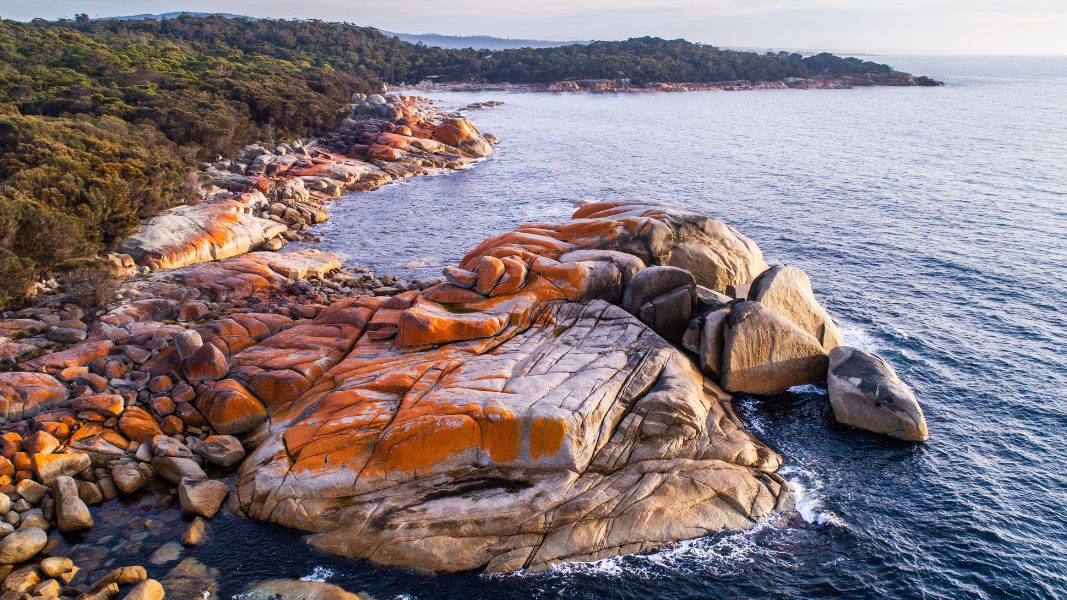


Join thousands of fellow campervan travellers
Sign up for our Britz newsletter to receive inspirational travel content and awesome deals, and we'll send you a copy of our Ultimate RV guide!
Thanks
Please confirm subscription in your email.
Is Bay of Fires worth it?
One hundred per cent, yes! Bay of Fires in Tasmania is the poster child for pristine beaches—think tranquil stretches of sand, shimmering shallows, and bright orange rocks. Beyond the Instagram-worthy scenery, the chilled-out atmosphere is perfect for beachcombing, stargazing, going for a leisurely hike, or simply switching off from the daily grind.
What is there to do? Well, first and foremost, the Bay of Fires is renowned for its stunning beaches. Cosy Corner is a favourite among visitors, thanks to its sheltered coves and pristine white sand. Another gem is Ansons Bay, located at the northern end of the Bay of Fires. This tranquil spot is ideal for fishing, kayaking, and birdwatching. For those who love a bit of adventure, Swimcart Beach offers excellent conditions for surfing and snorkelling.
Why is it called Bay of Fires, Tasmania?
The name dates back to 1773, courtesy of Captain Tobias Furneaux, who spotted Aboriginal fires blazing along the shoreline as he sailed by. These fires were lit by the Palawa (Tasmanian Aboriginal) communities who have called this remarkable region home for millennia. While “Bay of Fires” originally referred to those actual flames, many travellers link the name to the area’s iconic orange-tinged rocks. Either way, it’s a moniker that perfectly suits this fiery corner of Tassie’s northeast coast.

What town in Tasmania was Bay of Fires filmed in?
If you’ve caught wind of the TV series “The Bay of Fires” (2023), you might be surprised to learn that the majority of filming actually happened on Tasmania’s remote West Coast. Strahan—a tiny town that looks ripped straight from an adventure novel—served as the show’s main base. Its rugged landscapes and thick forests offer that moody, mysterious backdrop the series needed. While Bay of Fires itself (on the East Coast) inspired the name, the show’s storyline required something a bit moodier to match its dark themes.
How to get to the Bay of Fires
Road tripping to the Bay of Fires is a breeze—just pick up your campervan from Hobart and point it toward the east coast. Binalong Bay, at the southern end of the Bay of Fires Conservation Area, is a 2-hour and 20-minute drive (about 175 km) east of Launceston or a 3-hour and 20-minute drive (around 263 km) northeast of Hobart. If you want to slot Bay of Fires into a bigger adventure, check out this nine-day Tasmania self-drive for the ultimate round-island escapade.
Best time to visit the Bay of Fires
Looking for the Bay of Fires, Tasmania, best time to visit? Summer (December to February) is the MVP, boasting warm days for swimming, snorkelling, and general beach hopping. If crowds aren’t your thing, try spring (September to November) or autumn (March to May) for blissful solitude, cooler temps, and equally postcard-worthy scenery.
Weather for Bay of Fires
The Bay of Fires enjoys a mild coastal climate, meaning it’s rarely too hot or too cold to explore. Summers (December–February) usually hover around a comfortable 22°C, giving you plenty of reasons to take a dip. Winters (June–August) drop to about 12°C, which can be crisp but still perfectly fine for coastal walks—just pack a cosy jumper. Spring and autumn range between 13–20°C, so you can explore without breaking too much of a sweat. Expect moderate rainfall (roughly 120–150 wet days a year), but don’t fret—when the clouds clear, the dramatic skies over Bay of Fires beach make for sensational photos.
Things to do in the Bay of Fires
For those who love to explore on foot, the Bay of Fires offers some of the most scenic walks and hikes in Tasmania. One of the highlights is the Bay of Fires Lodge Walk, a guided trek that takes you through the local landscapes, from secluded beaches to lush coastal heathlands. If you’re up for a challenge, drive an hour north to Mount William National Park (Mt William National Park), where you can hike to the summit for panoramic views of the northeastern coast. The park is also home to a variety of wildlife, so keep your eyes peeled for kangaroos, wallabies, and an array of bird species. Don't want to venture far? The Bay of Fires Conservation Area is exploding with natural beauty and hikes (like the Skeleton Bay Lookout hike), so you can also keep close to camp if you prefer.
Where to stay in the Bay of Fires
For those who love the great outdoors, there are several free-to-use bush retreat bays where you can set up camp and fall asleep to the sound of the waves. Cosy Corner and Swimcart Beach are popular spots for camping, offering stunning ocean views and easy access to the beach. If you prefer a bit more comfort, there are also plenty of caravan parks and holiday homes available in St. Helens, just a short 30-minute drive south.
Road Trips that pass through the Bay of Fires on the Northeastern Coast
.png)